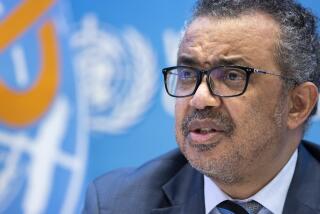Warning Flags on AIDS
- Share via
The World Health Organization is calling for a broader commitment to the efforts to contain the AIDS pandemic, warning that flagging interest is raising the risk of a more rapid spread of the human immunodeficiency virus (HIV) that causes the disease. It is a timely notice, coming as it does when many Americans seem to be paying less attention to the problem.
“The gap between the pace of the epidemic and the prevention and control efforts is threatening to widen,” according to Dr. Jonathan Mann, director of the WHO Global Program on AIDS. “Even though we can say today for the first time that activities against AIDS are now under way in every country in the world, we are locked in a race for control of an epidemic as fatal as any the world has ever known.”
WHO calculates that 5 million have been infected by HIV, that 600,000 have developed AIDS, that more than 300,000 have died. By the year 2000, the HIV-infected population will rise to 15 million, with the AIDS case total at 6 million and the cumulative death toll at more than 3 million. Those numbers could prove too low, however, if the epidemic takes hold in Asia. And, according to Dr. Mann, they might be reduced by 1 million if there is a toughening of national programs.
Estimates of the global AIDS case load are continuously being revised, and, without exception, they are being revised upwards, measuring the gravity of the situation. A study by world experts of that case load in May estimated a total of 375,000 AIDS cases. By June, however, Mann had revised that figure to 480,000. And in recent testimony to the National AIDS Commission, he further revised the estimate to 600,000.
In the absence of a cure, the only control is through prevention. But education and prevention programs, including sex education and distribution of condoms, have been lagging. There are particular threats of a spread of the disease now among the 5 million intravenous drug users scattered around the world, and among the 100 million persons who each year contract sexually transmitted diseases.
“Societies are still reluctant to confront the underlying problems which create and enhance vulnerability to AIDS,” according to Dr. Mann. “This entails tackling problems such as drug use, access to health services, discrimination, prostitute-client relationships and education of young people about sex.”
Mann warned in particular about the dangers of discrimination against people with behaviors that increase the risk of HIV infection or who have contracted the virus. “Ignoring discrimination may be politically expedient but it is dangerous to society and to public health,” he affirmed.
Global efforts are now characterized by a widening gap between what rich countries can do, extending the lives of infected persons with costly treatments, and what the poor nations are able to do, he noted. “The combined AIDS expenditures for California and New York exceed the resources currently available for AIDS in the entire developing world.”
But even in California, his counsel leaves no room for complacency. There is continued resistance to the kinds of education programs likely to be most effective in containing the spread of the virus at the critical points: Among young people, minorities, and intravenous drug users.
More to Read
Sign up for Essential California
The most important California stories and recommendations in your inbox every morning.
You may occasionally receive promotional content from the Los Angeles Times.










